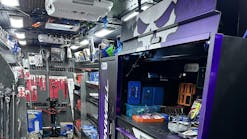Get up, eat breakfast, hug the kids, kiss the spouse, sell tools, collect payment, repeat
Sure we all have a day – every once in a while – where everything goes as planned. But every so often the days starts as follows … and it’s all downhill from there:
Get up late, customer calls about a broken tool, kids won’t get up for school, toast gets burned, another customer texts about a repair part that isn’t in yet, your son teases your daughter and she cries, spouse is a touch cranky, and you run out of the house swearing. Have a good day! Ha!
Everyone will also have those days that start off great and then disaster strikes just when you least expect it.
So what is a jobber to do? You still need to make your calls, collect your money, and sell something every working day.
When I was working full-time I was always the first one out of bed and got out of the house before the morning riot started, which worked great for me. This tactic doesn’t work for everyone.
My son, the Marine, tells me the USMC has a saying: “PPP Produces PPR.” P— Poor Planning Produces P— Poor Results. Yet reality tells us that Murphy’s Law is correct “If something can go wrong, it will.” An addition to this law reads: “…and usually at the worst time.”
Proper logical planning and thoughtful execution will help you save the day. But even good planning can depend on simple things like the geography of your route. I once rode with my local Matco jobber whose Schaumburg, Illinois area is about two by ten miles. Compared to someone in Montana who covers one-third of the state, jumping from here to there is not always possible because of factors like route size, traffic patterns, never ending construction, and weather issues. So, for the jobber in Schaumburg to go a mile out of his way to drop off that 1/2” socket it is not impossible, but for the Montana jobber this would be a real time-waster.
The following are some ideas that may help you plan a more successful sales day:
- Schedule big ticket item sales presentations and potentially long demonstrations for the end of the day. This allows you to take all the time you need to make the sale without worrying about your next stop. You will be relaxed and on your game, and the customer will not feel rushed to make a decision. When a customer feels rushed the answer is very often, “No.”
- When you get that late start or are held up you must carefully decide: Is it better to skip that location with one or two technicians and hit the big dealer on-time? Or should you do a halfhearted job on both calls, since you are trying to make up time? One good call is always better than two worthless ones. Would a phone call or text to the small location suffice? How about a text with the latest promotion attached?
- Speaking of brochures and promotions. Are you emailing or texting these to your customers as soon as you get them? This gets the word out and may build up some demand before you get there in person. It may also stifle a competitor’s promotion on the same products.
- If you have a support person working with you, can they run that 1/2” socket to the customer who called you at 7 AM?
- Set your schedule to provide a time midweek to take care of the week’s emergencies. Maybe set aside Wednesday morning for catching up on emergencies, talking to your favorite WD, reading PD magazine, or thinking through how to handle a major customer problem. A scheduled midweek “thinking time” will let you focus on your business plan and not cut into your family time in the evenings.
Planning and time management will save the day.
In Steven Covey’s best-selling book The Seven Habits of Highly Effective People, Covey’s third effective habit is to put “first things first.” He explains this with a presentation on the four quadrants of time management, which are:
I. Important and urgent – Do crises and emergencies
II. Important but not urgent – Plan prevention, planning, and improvement
III. Not important but urgent – Delegate interruptions and busy work
IV. Not important and not urgent - Eliminate time wasters
Here’s a summary of the meaning of each quadrant, and what it might mean for you:
Quadrant I – High urgency. The first quadrant contains tasks and responsibilities that demand immediate attention. Your truck won’t start! Your best customer or dealership calls and needs something now. You forgot your kid’s birthday and you need a present today! You need some sales today.
Quadrant II – Long-term development and strategizing. The second quadrant is for items that are important without requiring immediate action. Covey points out that this quadrant should be used for long-term strategizing. Learn a new selling skill. Develop a new local promotion. Run down your inventory before the next Matco Expo, Cornwell Rally, or ISN Tool Dealer Expo (to name a few).
Quadrant III – Distractions with high urgency. The third quadrant is reserved for tasks that are urgent, without being important. Covey recommends minimizing or even eliminating these tasks as they do not contribute to your output. Delegation is also an option here. A small customer needs a new 1/2” socket and just can’t wait until your stop there next week. Your DM wants a report on the sales of some new tool today because he forgot to ask you for it last week.
Quadrant IV – Activities with little to no value. The fourth and last quadrant focuses on tasks and responsibilities that do not yield any value—items that are unimportant and not urgent. These time wasters should be eliminated at any cost. Do you really need that stop at the donut shop? Your heart and waistline will thank you for skipping this one.
Published in 1989 The Seven Habits of Highly Effective People is still the number one business book best seller on Amazon!
Now go sell something.



